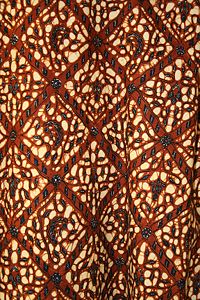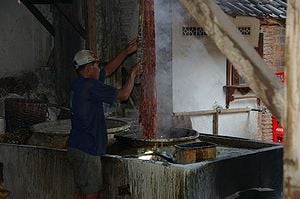Batik
- This article is about the textile dyeing technique. For other uses see Batik (disambiguation).
Batik (Javanese-Indonesian pronunciation: [ˈba.teʔ], but often, in English, is [ˈbætɪk] or [bəˈtiːk]) is an Indonesian word and refers to a generic wax-resist dyeing technique used on textile. The word originates from Javanese word "amba", meaning ”to write” and the Javanese word for dot or point, "titik."
It is known to be more than a millennium old, probably originating in ancient Egypt or Sumeria. There is evidence that cloth decorated through some form of resist technique was in use in the early centuries AD.[citation needed] It is found in several countries later in West Africa such as Nigeria, Cameroon and Mali, or in Asia, such as India, Sri Lanka, Bangladesh , Iran, Thailand, and Malaysia, but the most popular are in Indonesia.
Culture
Batik has been both an art and a craft for centuries. In Java, Indonesia, batik is part of an ancient tradition, and some of the finest batik cloth in the world is still made there.
Contemporary batik, while owing much to the past, is markedly different from the more traditional and formal styles. For example, the artist may use etching, discharge dyeing, stencils, different tools for waxing and dyeing, wax recipes with different resist values and work with silk, cotton, wool, leather, paper or even wood and ceramics.
Batik is historically the most expressive and subtle of the resist methods. The ever widening range of techniques available offers the artist the opportunity to explore a unique process in a flexible and exciting way..
Procedure

Melted wax is applied to cloth before being dipped in dye. It is common for people to use a mixture of bees wax and paraffin wax. The bee's wax will hold to the fabric and the paraffin wax will allow cracking, which is a characteristic of batik. Wherever the wax has seeped through the fabric, the dye will not penetrate. Sometimes several colors are used, with a series of dyeing, drying and waxing steps.
Thin wax lines are made with a canting needle, a wooden handled tool with a tiny metal cup with a tiny spout, out of which the wax seeps. Other methods of applying the wax onto the fabric include pouring the liquid wax, painting the wax on with a brush, and applying the hot wax to precarved wooden or metal wire block and stamping the fabric.
After the last dyeing, the fabric is hung up to dry. Then it is dipped in a solvent to dissolve the wax, or ironed between paper towels or newspapers to absorb the wax and reveal the deep rich colors and the fine crinkle lines that give batik its character.
The invention of the copper block or cap developed by the Javanese in the 20th century revolutionised batik production. It became possible to make high quality designs and intricate patterns much faster than one could possibly do by hand-painting.
Indonesian batik used for clothing normally has an intricate pattern. The traditional ones carry natural colors while the contemporary ones have more variety of color. Some batik may be mystic-influenced, but very rarely used for clothing. Some may carry illustrations of animals and people.
Further reading
- Elliott, Inger McCabe. (1984) Batik : fabled cloth of Java photographs, Brian Brake ; contributions, Paramita Abdurachman, Susan Blum, Iwan Tirta ; design, Kiyoshi Kanai. New York : Clarkson N. Potter Inc., ISBN 0517551551
- Fraser-Lu, Sylvia.(1986) Indonesian batik : processes, patterns, and places Singapore : Oxford University Press. ISBN 0195826612
- Doellah, H.Santosa. (2003). Batik : The Impact of Time and Environment, Solo : Danar Hadi. ISBN 9799717310
See also
- Madiba shirt
| |||||||||||||||||||||||||||||||||||||
jv:Batik
Credits
New World Encyclopedia writers and editors rewrote and completed the Wikipedia article in accordance with New World Encyclopedia standards. This article abides by terms of the Creative Commons CC-by-sa 3.0 License (CC-by-sa), which may be used and disseminated with proper attribution. Credit is due under the terms of this license that can reference both the New World Encyclopedia contributors and the selfless volunteer contributors of the Wikimedia Foundation. To cite this article click here for a list of acceptable citing formats.The history of earlier contributions by wikipedians is accessible to researchers here:
The history of this article since it was imported to New World Encyclopedia:
Note: Some restrictions may apply to use of individual images which are separately licensed.

